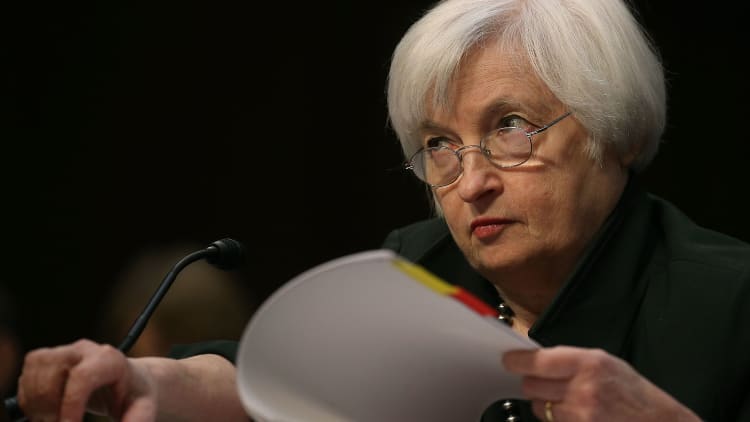
A recent string of less-than-stellar economic news has injected some uncertainty into whether the Fed will deliver a steady diet of rate increases ahead.
In fact, current trading in the fed funds futures market indicates that the U.S. central bank will not be able to enact the two additional rate hikes that officials have indicated are on the way this year.
As of Thursday afternoon, market indications were for a 57.3 percent chance of a quarter-point increase in the benchmark short-term rate in June, while there's just a 41.1 percent probability that it would move again in December. The June probability was less than 50 percent on Wednesday but rose Thursday on the heels of better-than-expected 0.4 percent growth in the leading economic indicators barometer and a stock market rally.
Those expectations are counter to the past couple of months, when investors grew more comfortable with the idea that the Fed would be able to lift rates off their crisis-era lows. The first rate hike since mid-2006 happened in December 2015, with the next one not coming again until December 2016. The policymaking Federal Open Market Committee hiked again in March, with officials then pointing to a total of three moves for the year.
However, the 2017 projection came amid higher hopes for growth and a belief that inflation and labor market slack were progressing toward the Fed's goals.
Christine Lagarde, managing director of the International Monetary Fund, said the Fed will have to proceed carefully amid the swirling crosscurrents.
"If it moves too fast, that's where we might have risk, because capital flows will move back from emerging markets into the U.S. market, and that could precipitate some disorderly adjustments in those other countries," Lagarde told CNBC in a live interview. "Let's hope it proceeds in a smooth, well-communicated and orderly manner, as fact-based as possible, as has been the case so far."
The economic signals of late have not been conducive to a central bank looking to normalize policy after years of cheap money.
Since the last FOMC meeting, a key inflation indicator fell for the first time since January 2010, the March nonfarm payrolls report significantly missed Wall Street expectations and the Atlanta Fed now expects the economy to show growth of just 0.5 percent for the first quarter.
On top of that, President Donald Trump's pro-growth agenda has hit a bit of a wall in Congress.
"If you look at the data in the first quarter, it's suggestive of a slowing down in the economy," said Quincy Krosby, market strategist at Prudential Financial. "There's a fear that we're losing momentum."
However, one prominent economist thinks traders are getting it wrong on rates.
"Market pricing of future Fed rate hikes has declined in the wake of weaker GDP and inflation data, signals of an earlier Fed balance sheet runoff and reduced optimism on fiscal easing," Jan Hatzius, chief economist at Goldman Sachs, said in a note. "But markets may be underestimating three factors pointing toward continued steady hikes."
Better growth, less Trump danger
Specifically, Hatzius cites easing financial conditions, continued optimism that the Trump agenda will be put into action at some point and a tightening labor market that will push the Fed to act.
Indeed, the Chicago Fed's financial conditions index is showing the loosest readings since around December 2014. The Atlanta Fed's wage growth tracker, while falling from October through February, ticked back up in March to show a 3.4 percent gain.
And the Fed broadly, in its periodic Beige Book report Wednesday on financial conditions across the country, mentioned "wage increases" a dozen times, and always in conjunction with upward pressure to varying degrees.
Trump's success in Congress remains, however, the wild card in the bunch. However, Hatzius holds a view recently also espoused by Moody's Analytics economist Mark Zandi that, at the very least, the most growth-stifling parts of the Trump agenda have become less threatening.
"While the growth-positive aspects of the Trump agenda have hit rougher air, the growth-negative aspects also look less concerning," Hatzius said. "In particular, the specter of protectionism — a major source of concern during the transition especially for trade with China and Mexico — has clearly receded in recent months."
Still, the perception persists that the Fed is overestimating the economy's growth capability.
David Rosenberg, senior economist and strategist at Gluskin Sheff, believes the U.S. is in a late-stage expansion that will be threatened by further Fed tightening.
"Unless you think the business cycle has been repealed and that there will be no repercussions from the Fed tightening into a 3 percent to 4 percent nominal GDP growth environment, or that we will see gridlock end in Washington and all the Trump pro-growth policy proposals coming to fruition, then there is little reason to believe that the U.S. economy will break out of its current malaise," he said.
Fed Chair Janet Yellen, who has maintained a tight consensus during her time leading the FOMC, likely will remain focused on inflation pressures and the jobless numbers.
In fact, low GDP numbers haven't bothered the Yellen Fed very much. The December 2015 hike came amid 0.9 percent quarterly growth, while the March move came in a period also unlikely to eclipse a 1 percent gain.
Watch: Fed's Beige Book highlights



